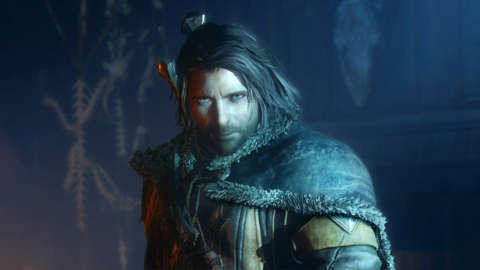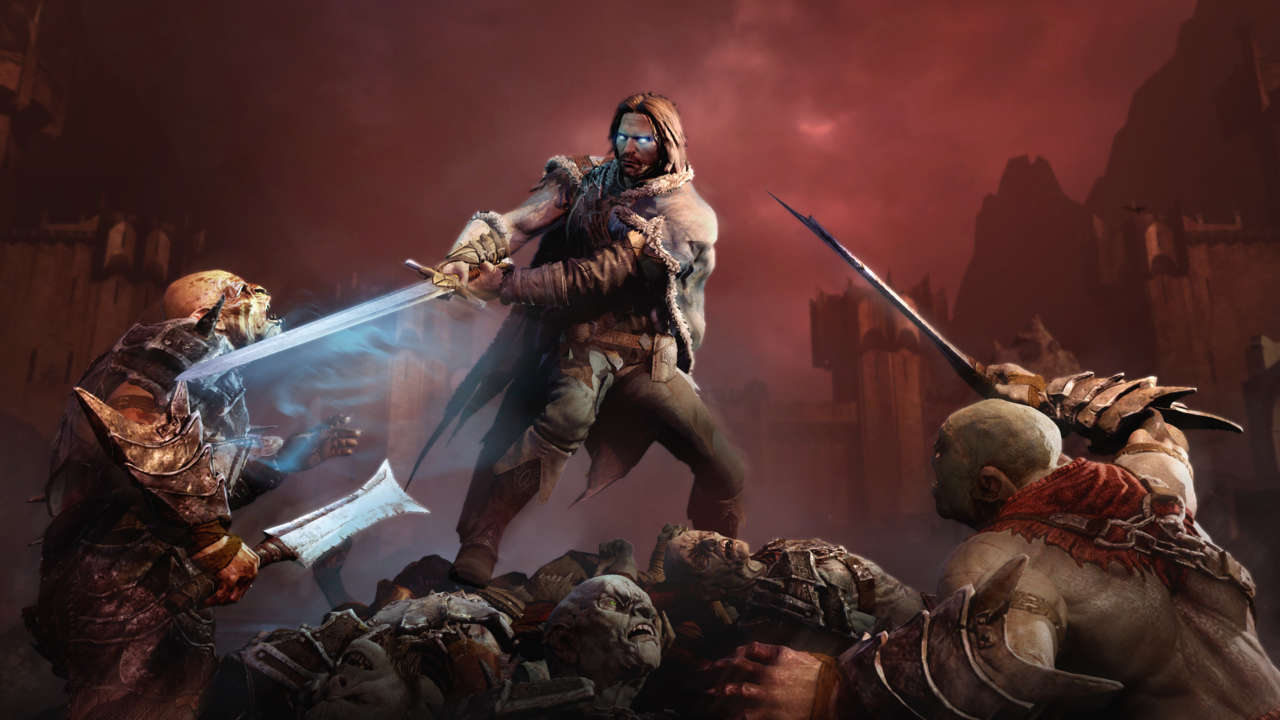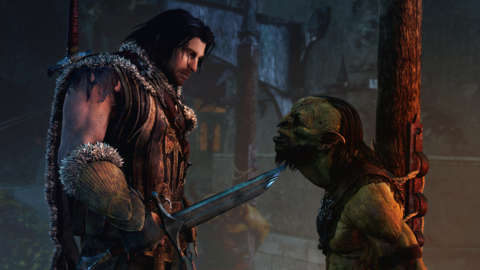It’s mid-July, and I'm sitting in a room with the charming and diplomatic Michael de Plater, director of design for the upcoming Middle-earth: Shadow of Mordor. I've just seen the trailer embedded below, and already I've gone off on a tangent, chatting with de Plater about Gollum's animations, the thankless task of designing certain game elements that players only notice when they're bad, and the stresses of releasing a game set in such a well-known, well-loved fantasy universe.
Eventually, however, we turn the conversation to a more relevant subject: developer Monolith and publisher Warner Bros. Interactive will be confirming the identity of Shadow of Mordor's other main character--the wraith that shares a body with resurrected ranger Talion--at San Diego Comic-con. As it happens, the wraith is Celebrimbor, the Noldorin prince that forged the Rings of the Elves, though that won't come as much of a surprise to keen observers. (Even before the Comic-con reveal, Wikia's Shadow of Mordor wiki already states it as brute fact.)
Fallout 4 Next Gen Update Comparison Stellar Blade - Hard Mode No Damage Gigas Boss Gameplay Stellar Blade - Hard Mode No Damage Abaddon Boss Gameplay Stellar Blade - (Almost) All Outfits Granblue Fantasy: Relink - New Content Trailer Modern Warfare III - New Season 3 Reloaded Modern Warfare Zombies Update Stellar Blade - 13 Things I Wish I Knew S.T.A.L.K.E.R. 2: Heart of Chornobyl — Official "Not a Paradise" Trailer Honkai: Star Rail - "Then Wake to Weep" | Version 2.2 Trailer Devil May Cry: Peak Of Combat | Dante: Blazing Tempest Gameplay Trailer SAND LAND — Official Launch Trailer Sea of Thieves Season 12: Official Content Update Video
Please enter your date of birth to view this video
By clicking 'enter', you agree to GameSpot's
Terms of Use and Privacy Policy
We should probably get to the big news, the announcement that you guys are making for Comic-con. What are you revealing?
We've talked a lot about the living world and the nemesis system, but not a lot about the story, and we've talked about Talion a little bit, but really, we actually do have two main characters of pretty much equal weighting in terms of their stories and the role that they play. Something we went back and forward a lot on is, how big of a spoiler is it to reveal that the wraith is in fact this character of Celebrimbor as well?
All of the people who have explored the lore deeply enough can work out who he is anyway, from his traits, and his attributes, and that he forged the Rings of Power, and so on. For the people who haven't heard of him, or have seen the movies, it's just a little bit of research. It's really interesting to discover this character who is more complex and more nuanced than maybe what we think of most elves. And plus, going into the game with that little bit of back knowledge, that'll be extra history for where we take our story from that point--the twists, the turns, the revelations, and how we move towards the conclusion, and how the conflict with Sauron gets even richer.

That's what we're excited about with Comic-con, revealing who this guy is, why we chose him as a character, why he's so interesting, what his relationship to Sauron is. And also, I think the authenticity he brings to even the gameplay itself--one of the assumptions people sometimes make in Tolkien is the level of power in some of the characters, because they don't see Gandalf fling the fireballs around, that that sort of level of power is somehow inauthentic. But of course, Gandalf is restricted, there are rules placed on him that he's not allowed to do that. He can't take on Sauron toe to toe, he can't match him in power, he has to work by inspiring people and bringing out the best in others.
Celebrimbor is not someone who has that restriction. He is in the situation Galadriel was in when Frodo said "I'm offering you the ring of power." Galadriel's reaction was that you wouldn't have a dark lord but a dark queen, so I'm not going to do that. Celebrimbor is obviously a much prouder character, a much darker character. Partly he wants to bring down Sauron, but partly he's also trying to achieve a redemption for what seem like his sins, his shame in allowing himself to be deceived by Sauron.
I've seen reactions both positive and negative to the idea of this sort-of wraith/human hybrid. From what you've seen, what's been the reaction to the idea, and are you hoping that with more explanation for the story coming out, that that will help buoy people's understanding?

The level of power--and by power, I mean the way Tolkien means power--of a character like Celebrimbor does add to the authenticity and the feasibility. The one I get frustrated with is, sometimes people say "Oh, we haven't seen exactly this thing before in Tolkien's writings, we haven't seen an exact example of this type of wraith, therefore it can't happen." But in reading Tolkien, there's nothing like the army of the dead until we've seen the army of the dead. There's nothing like the barrow-wights until we've seen the barrow-wights. There's nothing like the dead marshes until we've seen the dead marshes. There's not exactly a consistent way in which the ringwraiths are handled. Do they have flesh? Do they not have flesh? Are they physical? Are they corporeal? Are they incorporeal? I think a key part of the authenticity is that you do want to introduce something with a bit of mystery and a bit of wonder, but is still authentic in the canon, in the myth, in what we already know. I don't think we would ever want to limit ourselves to only showing things that have been specifically included or shown in the books.
I don't think there's ever a situation where you're going to make every purist happy. There's a guy, probably one of the most respected Tolkien scholars in the world--he was also one of the consultants on the films, a guy called Tom Shippey. And he gave a really good lecture the other day--there's a link to it on theonering.net--and he basically spoke to that point. There's a group of people whose greatest pleasure is pointing out faults or flaws, and the way he expressed it was, "the prize goes to the person who makes the biggest fuss about the smallest detail."
Partly he wants to bring down Sauron, but partly he's also trying to achieve a redemption for what seem like his sins, his shame in allowing himself to be deceived by Sauron.
Michael de Plater, Director of Design, Middle-earth: Shadow of Mordor
The single biggest thing for us that we've adapted to suit our story is also something changed in the films. In the Hobbit movie, we see that they go to the tomb in Fornost, and we see that the Witch-king has escaped from his tomb. The Witch-king of Angmar, when he was defeated thousands of years ago, his body was entombed and now he's resurrected, and both he and Sauron are back. In the movie that worked really well, but it's really compressing a timeline of a lot of things that actually happened in the books. And we've actually done that one as well, so we've compressed that timeline that said that Sauron and the Nazgul have reawakened at that time and have returned.
It's not changing anything per se, but shuffling around some of the events--but to some people, that's a really big deal, because it was the Witch-king who fled at the Battle of Fornost, and Glorfindel said "No, don't chase him because there's no point, it's not by the hand of man that he will die." That's the prophecy that ultimately feeds into where Eowyn stabs the Witch-king in the face and says "I am no man." Shifting that detail does have ripple effects, so there's little things like that--little or not so little. Overall it's about being as authentic as possible, but I don't see any scenario in which you make everyone absolutely happy.

Usually we see Lord of the Rings stories that feature characters we know, and take place in places we spend a lot of time in in the novels. In Shadow of Mordor, we spend a lot of time with characters that we don't know in Mordor, a place that hasn't been greatly explored in games. It seems like you've got a much longer leash attaching you to the world, a much larger space in which to work your magic and do something original with.
I can't remember who said it, or what [intellectual property] they were saying it in relation to, but that they were trying to copy the disease and not its symptoms. Those two things which you just mentioned, one is constantly visiting new places and seeing things that haven't been done, and Tolkien does that constantly. Between The Hobbit and The Lord of the Rings, they touch in a couple of places, but overall, you're constantly seeing new things as well. You find something highly detailed and iconic like Gollum, so you can anchor on it, but then there are all these spaces you can go in. And I think it's what helps the overall scale of the world feel bigger and more authentic, and again, The Hobbit, it's a standalone story with all these threads and connections to The Lord of the Rings.
I don't think there's ever a situation where you're going to make every purist happy.
Michael de Plater
Like The Necromancer hardly gets touched on in The Hobbit but is obviously a really key character, and these are big events. In the same way, Celebrimbor is great, because he's not actually mentioned very often, but he's really key, forging the Rings of Power, and also key as an elf who isn't just a good guy. We wanted to follow The Hobbit [as it relates to The Lord of the Rings], something that works as an epic standalone story with tendrils that go out to the big picture.
We've got Peter Jackson's vision of what these places and people are like, and for a lot of people, that's what we think about. Do you ever find yourself feeling limited in what you can do, because another artist has gotten there first? Do you feel beholden to staying true to that person's vision even when they don't stay close to the original details?
The thing that was most inspiring about the movies from the get-go is that they are very true to the spirit of the books and most of the details, and whenever something does change, it's for a very good reason that makes for a better movie. They are as authentic as they can be while still being the best movies they can be. We try to follow the same philosophy, absolutely as authentic, and all the attention to detail, and if anything is changed at all, in the same way if they change anything it's to make a better film, we're doing it to make the best game that we can make. Different media do have some differences, and we want to make the best game we can make that's absolutely true to the material.
So you've got these examples of what Peter Jackson's movies are compared to Tolkien's books, or what the Arkham games are compared to Chris Nolan's movies, and so you do the absolute best thing you can do within your own medium that's also as true as you can possibly make it. And not just retelling the same stories people have already seen, which is a fundamentally dull thing--it's not something Tolkien ever did, or would ever do, is just retread the same ground. But trying to be authentic and trying to tell a good standalone story.

One of the first things that struck me when I first saw Shadow of Mordor was its pervasive sense of weight and dread. In The Lord of the Rings novels, we get respite, we get an oasis. I'm curious--you've got a universe that's not just Mordor, but you've got The Shire, you've got Rohan, you've got lots of complementary ideas. When you've got a game that takes place in Mordor, how do you provide an oasis to the player?
That was a really important issue for us, and we attacked it from a few different directions. Firstly, it was part of the fun of Mordor at this time--Sauron has just returned, he hasn't been there for two-thousand years, so we don't have to make it into the blasted hellscape that we see later. It is more of a place that's in transition, so there are bits of it that are still green. And it's interesting to think of Mordor as a living place; Sauron has to feed armies, he has to grow crops, he can't just have this blasted land with troops marching over--it has to function. It's on the brink of this totalitarian domination, but it's still turning into that.

The other approach to that was in the writing. [Lead writer] Christian [Cantamessa] and [voice actors] Troy [Baker] and Alistair [Duncan] did a great job of bringing humor into the story so that it's not constantly grim and dark, and there are some really relatable moments in there. Additionally--it's obviously weighted more towards dark humor--but one of the key writers we had on the nemesis system was a guy called Dan Abnett, and he's written a bunch of great comics. With Andy Lanning he did a lot of the Guardians of the Galaxy reboot that's become the next big Marvel thing, and he did some of the best Warhammer 40K novels, where I think his are differentiated by injecting some humanity and some humor into them.
I think that humor is really important to lift the tone, and that's a key part of the nemesis system. People want to meet and re-encounter these [orcs], they want to hear what they're going to say--that combination of having them remember you and reacting to you, and having lots of amusing stuff to say, really does lighten it. And then there's down time. If you don't want the relentless combat, or pursuing the story, there's a lot of secrets to uncover and explore. You can uncover the history and learn more about the lore, learn about the wraith and the history of Mordor.
So game players and even people like in the media like to condense games into a simple description. We might say [Shadow of Mordor] is sort of like Assassin's Creed in Mordor, or it's Batman: Arkham Asylum in Mordor. Do you think the project has been helped or hindered by those kinds of comparisons?

They do both. On balance, I think it's a good thing. It's an entry point, we exist within a genre, open-world third-person action. People will always map you to something. We're mapped to an action game. We have strong [role-playing game] elements, and a lot of the time people see fantasy and the first place they're gonna go to is they're gonna think you're an RPG. The fact that people are mapping us to an action game, and understanding that moment-to-moment action and gameplay, is a good thing. If they didn't do that, maybe they'd be mapping us more to The Witcher, Dragon Age, or Skyrim.
For us, it's a big deal when people get their hands on it, because when they start to play, there's impressions that people get and reactions that they have is that there's more to it. If there is an area where it's fine for people to make comparisons, it's that we want people who have played Batman to pick [Shadow of Mordor] up and feel comfortable with the controls.
So surely you're ready to move on to new projects now. Shall I assume that Condemned 3 and a new No One Lives Forever are in the works?
[Smiles.]

